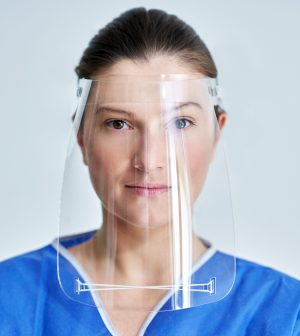- Skip Storing This Everyday Product in the Fridge Door
- Green Tea + B3 Pairing May Boost Brain Health
- Navigating Your Midlife Crisis: Embracing New Possibilities
- City Raccoons Showing Signs of Domestication
- Mapping the Exposome: Science Broadens Focus to Environmental Disease Triggers
- One Week Less on Social Media Linked to Better Mental Health
- Your Brain Changes in Stages as You Age, Study Finds
- Some Suicide Victims Show No Typical Warning Signs, Study Finds
- ByHeart Formula Faces Lawsuits After Babies Sickened With Botulism
- Switch to Vegan Diet Could Cut Your Greenhouse Gas Emissions in Half
Face Shields No Match for COVID Spread

Clear shields that cover in front of the face have been a fairly frequent sight since the COVID-19 pandemic began.
They’re worn with or without a mask on the nose and mouth.
Though these face shields do offer some protection, none of 13 styles studied offered high protection against potentially infectious droplets, according to researchers from the University of East Anglia (UEA), in the United Kingdom.
“Face shields have been popular because they don’t hinder breathing, they allow more natural communication than face masks and they provide splash protection,” said Paul Hunter, a COVID expert and professor at UEA’s Norwich Medical School.
“But until now there hasn’t been a great deal of evidence about how protective they really are – particularly taking into account how people use them in the real world, and especially in poorer parts of the world,” Hunter said in a school news release.
For the study, the researchers tested the face shields in controlled laboratory settings in collaboration with the Health and Safety Executive, Britain’s regulator for workplace health and safety. The team used using a “coughing machine” that ejected fluorescent drops onto manikin heads. Then, they graded the face shields based on how they were contaminated by the simulated cough droplets.
“The lab tests showed that all of the face shields provided some protection, but none gave high levels of protection against external droplet contamination. The level of protection provided was influenced by design features, as well as which way the manikin had its head turned when it was ‘coughed’ at,” said Dr. Julii Brainard from UEA’s Norwich Medical School.
Large gaps around the sides, and sometimes the bottom or top, allowed respiratory droplets from other people to get to the face, the findings showed.
“This means exposure to possible viruses,” Brainard said.
The shields that offered the most protection were closed across the forehead and extended well around the sides of the face and below the chin, she noted.
“It’s important to know that the lab experiments are in the scenario of someone actively coughing at the shield wearer from close proximity. But the chances of droplets getting around the shield onto the face from just speaking are much lower,” Brainard added
The findings were published July 28 in the American Journal of Infection Control.
More information
The U.S. Centers for Disease Control and Prevention has more on protecting yourself and others from COVID-19.
SOURCE: University of East Anglia, news release, July 27, 2022
Source: HealthDay
Copyright © 2025 HealthDay. All rights reserved.










